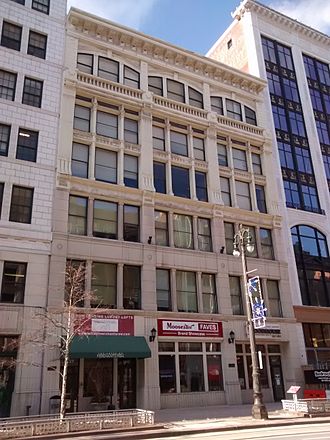- This page was last modified on 17 October 2025, at 10:18. Suggest an edit.
Frank & Seder Building (Detroit) facts for kids
| Lofts of Merchants Row | |
|---|---|
 |
|
| Former names | Frank & Seder Department Store Building |
| General information | |
| Status | Complete |
| Type | Residential condominium |
| Architectural style | Chicago school |
| Location | 1447 Woodward Avenue Detroit, Michigan |
| Coordinates | 42°20′05″N 83°02′58″W / 42.33463°N 83.04958°W |
| Completed | 1881 |
| Height | |
| Roof | 41 m (135 ft) |
| Technical details | |
| Floor count | 6 |
| Design and construction | |
| Architect | Kramer Design Group (renovation) |
| Other information | |
| Number of units | 28 |
The Lofts of Merchants Row is a tall building in downtown Detroit, Michigan. It stands about 41 meters (135 feet) high and has 6 floors. This building was finished in 1891. For a while, it was the tallest building in Michigan!
This building used to be called the Frank & Seder Department Store Building. In 1921, a larger part was added to the south. The top part of the building's front is made of cast iron. It is thought to be the last cast iron front of its kind in Detroit. Today, the building has 28 homes inside.
Contents
The Frank & Seder Department Store
Frank & Seder was a popular department store chain. It was started by two Russian Jewish immigrants, Isaac Seder and Jacob H. Frank. They first sold women's clothes wholesale. Later, they opened their first retail store in Pittsburgh in 1907.
Growing the Business
The business grew quickly. Frank & Seder opened stores in other big cities. These included New York City, Philadelphia, and Detroit.
In 1917, the Pittsburgh store was damaged by a fire. A new store was built and opened in 1918. The Philadelphia store also grew. It opened in 1915 and became much larger in 1925. Another smaller store for women's clothes opened in Philadelphia in 1929.
The Detroit Store
The Frank & Seder store in Detroit was built on Woodward Avenue. It was an eight-story building. Part of the store opened in April 1921 while it was still being built. The company had big plans for this Detroit location.
In 1923, a company called National Department Stores bought the Frank & Seder stores. This included the stores in Pittsburgh, Philadelphia, and Detroit. Frank & Seder also leased space in a building in New York City in 1921.
Challenges and Closing
Like many businesses, Frank & Seder faced challenges. In 1937, the Detroit store had some worker protests. These protests were happening in many places in Detroit at that time.
The Philadelphia branch store closed in 1949. This happened because it lost its lease to another store. In 1950, the main Philadelphia store tried a fun idea. They offered free movies for children on Saturday afternoons. This was a way to help parents shop.
The Frank & Seder chain closed its Detroit store in 1951. Its last Philadelphia store closed in 1953. The Pittsburgh store closed in 1958. It still stands today at Fifth Avenue and Smithfield Street. The Philadelphia store was taken down in 1959 to make space for a parking garage.
See also
 In Spanish: Frank & Seder Building para niños
In Spanish: Frank & Seder Building para niños
